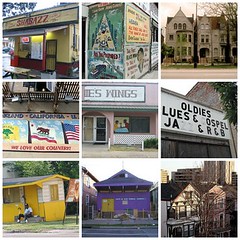The Rolling Jelly Series (5): Free, easy New Orleans
[Here is Part 5 of the Rolling Jelly Series.]
New Orleans at the turn of the 20th Century was, as Jelly Roll Morton described it to Alan Lomax, "a free and easy place. Everybody got along just the same.” Perhaps, in the wake of Katrina, that sounds quite different from the modern New Orleans, which many have portrayed as a city of shameful divisions, its good-time façade concealing awful racial tensions and poverty. But as I’ve said elsewhere, I think a lot of that kind of commentary was motivated by the simple urge to project such problems onto one, distant place, rather than the deal with the extent to which the same issues bedevil every city in contemporary America.
“There wasn't no certain neighborhood for nobody to live in, only with the St. Charles Avenue district, which is considered the millionaire district," Morton said of his years in New Orleans, and there is something in this observation that holds true, in my opinion, a century later. I remember reading a certain lefty journalist railing about how the Lower Garden District should be converted into a mixed area as New Orleans rebuilds. If you look at the actual data you will learn that it was already a mixed area when Katrina hit. More mixed in terms of race and class groupings, I dare say, than the neighborhoods your typical lefty journalists inhabit. The problem with New Orleans was not that it had hidden away a few terrible pockets of poverty out of sight in a mostly affluent city. New Orleans was a largely poor-to-working-class city, with one or two pockets of affluence – like the “millionaire district” a bit further upriver on St. Charles. That little part of town, the place Morton referred to, is also the place where a handful of paranoid rich people called in private security commandos to defend their valuables after Katrina.
"Everybody just went anyplace they wanted,” Morton told Lomax. “Many times you would see some of those St. Charles Avenue bunch right in one of those honky tonks. They called theirselves slumming, I guess, but they was there, just the same. Nudging elbows with all the big bums."
Morton was glossing race and class ugliness of course, and I’d be doing the same if I pretended there were no problems. There were problems. But I believe in a world that’s not either/or, but both. New Orleans was both a free and easy place, and a troubled one. It was both a place where everybody just went anyplace they wanted – and a place where there were some pretty significant exceptions to that rule. In other words, the New Orleans Morton talked about sounds familiar, to me.
<-- Part 4. Part 6 -->



1 Comments:
I think this is exactly right. Yes, obviously New Orleans has huge disparities of wealth and poverty. Yes, obviously it is, in it's way, a very racially divided city. But there's still a certain ease of rapport and a general tolerance between the disparate groups caused in part, I believe, by the particular shape of the city's social fabric. There are very few large blocks of homegenous groups. It's a finely grained checkerboard with with lots different people living their lives in close proximity to each other, shopping at the same stores, and generally seeing a lot of each other. And that frequency of contact tends to create at least some very basic level of mutual understanding and acceptance.
Post a Comment
<< Home